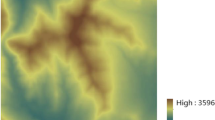Abstract
According to the problem that the elevation data does not reflect the slope and surface roughness of target topography, the preprocessing of topographic elevation data and extraction algorithm of topographic feature are proposed, and the corresponding extraction of topographic feature is done. A terrain risk assessment method is presented based on terrain roughness and slope information fusion, aiming at the problem that terrain roughness and gradient cannot be directly reflected from the terrain elevation data, in this paper. The innovation is that it is the first time that the bilinear interpolation algorithm is applied in preprocess of elevation data and extraction of topographic feature, as well as the terrain roughness and gradient information fusion algorithm are applied to terrain feature extraction and risk assessment for the first time. By simulation and checking calculation of a certain digital topography example, it is proved that the extraction method of topographic information based on elevation data is feasible and reliable. It will provide a new research approach for target information recognition and topography risk assessment accurately.



















Similar content being viewed by others
References
Bay, H., Ess, A., Tuytelaars, T., SURF.: Speeded up robust features [C]. In: GRAZ: European Conference on Computer Vision, pp. 404–417 (2006)
Yang, F., Wei, L., Zhang, Z.: Image mosaic based on phase correlation and harris operator [J]. J. Comput. Inf. Syst. 8(6), 2647–2655 (2012)
Yanhui, S., Kunyu, T., Jian, W.: A new seeded region growing algorithm for large object segmentation [C]. In: BMEI: International Conference on Biomedical Engineering and Informatics, pp. 47–51 (2011)
Lang, X., Zhu, F., Hao, Y.: Fast two-dimensional Otsu algorithm based on integral image [J]. Chin. J. Sci. Instrum. 30(1), 39–43 (2009)
Raizer, V.: Multisensor data fusion for advanced ocean remote sensing studies [C]. In: Geoscience and Remote Sensing Symposium (IGARSS), pp. 1622–1625. Melbourne, VIC (2013)
Li, X., Liu, T., Deng, S.: Fast recognition of hand vein with SURF descriptors [J]. Chin. J. Sci. Instrum. 32(4), 831–836 (2011)
Yu, H., Jin, W., Liu, X.: An objective assessment method of digital image mosaic artifacts visibility based on visual perception [J]. Acta Armament. 31(9), 1209–1215 (2010)
Owen, J.P., Ziv, E., Bukshpun, P., et al.: Test-retest reliability of computational network measurements derived from the structural connectome of the human brain [J]. Brain Connect 3, 160–176 (2012)
Rubinov, M., Sporns, O.: Complex network measures of brain connectivity: uses and interpretations [J]. Neuroimage 10, 1059–1069 (2009)
Salvador, R., Peña, A., Menon, D. K.: Formal characterization and extension of the linearized diffusion tensor model. Hum [J]. Brain Mapp. 24, 144–155 (2007)
Schwarz, A.J., McGonigle, J.: Negative edges and soft thresholding in complex network analysis of resting state functional connectivity data. Neuroimage 55, 1132–1146 (2010)
Tustison, N.J., Avants, B.B., Cook, P.A., et al.: N4ITK: improved N3 bias correction. IEEE Trans. Med. Imaging 29(6), 1310–1320 (2010)
Landman, B.A., Huang, A.J., Gifford, A.: Multi-parametric neuroimaging reproducibility: a 3-t resource study. Neuroimage 54, 2854–2866 (2010)
Bassett, D.S., Brown, J.A., Deshpande, V.: Conserved and variable architecture of human white matter connectivity. Neuroimage 54, 1262–1279 (2010)
Xue, R., Van Zijl, P.C., Crain, B.J.: In vivo three-dimensional reconstruction of rat brain axonal projections by diffusion tensor imaging. Magn. Reson. Med. 42, 1123–1127 (2006)
Zalesky, A., Fornito, A., Harding, I.H.: Whole-brain anatomical networks: does the choice of nodes matter. Neuroimage 50, 1201–1215 (2009)
Sumathi, C.S., Kumar, A.V.S.: Neural network based plant identification using leaf characteristics fusion. Int. J. Comput. Appl. 89(5), 31–35 (2014)
Hartley, R.: Kruppa’s. equations derived from the fundamental matrix. IEEE Trans. Pattern Anal. Mach. Intell. 19(2), 133–135 (2007)
Mahamud, S., Hebert, M., Omori, Y et al.: Provably-convergent iterative methods for projective structure from motion. In: IEEE International Conference on Computer Vision and Pattern Recognition, pp. 1018–1025 (2010)
Pollefeys, M., Van Gool, L.J., Vergauwen, M., et al.: Visual modeling with a hand-held camera. Int. J. Comput. Vis. 59(3), 207–232 (2004)
Gwo, C.Y., Wei, C.H.: Plant identification through images: using feature extraction of key points on leaf contours. Appl. Plant Sci. 1(11), 1–9 (2013)
Luo, N., Sun, Q., Geng, L.: An extended SURF descriptor and its application in remote sensing images registration. Acta Geod. et Cartogr. Sin. 42(3), 383–388 (2013)
Cheng, Y., Xue, D., Han, X.: Fast image mosaic based on wavelet transform for remote sensing. J. Northeast. Univ. (Natural Sci.) 29(10), 1385–1388 (2008)
Yang, B.: Image classification by latent topic model with dirichletian processes. J. Comput. Inf. Syst. 7(11), 3803–3810 (2011)
Pollefeys, M., Van Gool, L.J., Vergauwen, M., et al.: Visual modeling with a hand-held camera. Int. J. Comput. Vis. 59(3), 207–232 (2004)
Li, H., Chen, H.: A visualization method for multi-relation in dataset. Clust. Comput. 20(1), 225–237 (2017)
Zhang, X.M., He, G.J.: Spectral-spatial multi-feature classification of remote sensing big data based on a random forest classifier for land cover mapping. Clust. Comput. 20(3), 2311–2321 (2017)
Acknowledgements
This paper is supported by Project from education department of Shaanxi Province (No. 16JK1366), president fund from Xi’an Technological University (No. XAGDXJJ1404), Key Problem Tackling Project of Shaanxi Scientific and Technological Office (No. 2016GY-024) and non-traditional machining Key Laboratory Project of Shaanxi Province (No. 15JS041).
Author information
Authors and Affiliations
Corresponding author
Rights and permissions
About this article
Cite this article
Wang, Q., Cao, Y., Bai, Y. et al. The data analysis of roughness extraction of target topography using minimum median plane fitting method. Cluster Comput 22 (Suppl 4), 10385–10395 (2019). https://doi.org/10.1007/s10586-017-1582-0
Received:
Revised:
Accepted:
Published:
Issue Date:
DOI: https://doi.org/10.1007/s10586-017-1582-0




